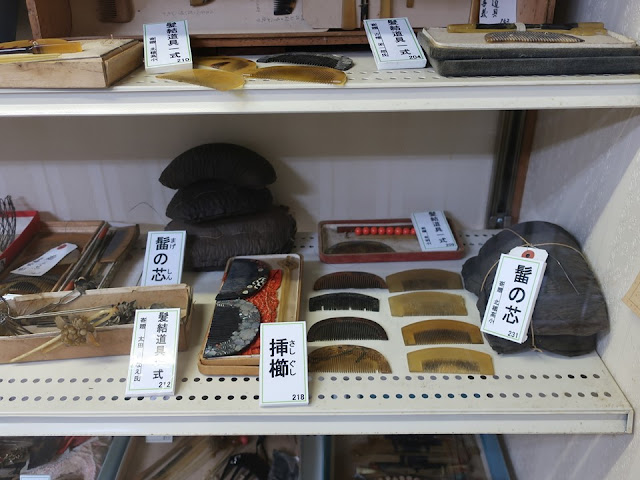The museum displays abundant everyday goods
for working, cooking and so on. We can understand old local lives easily.
Exhibits about Mr. Kobayashi, who opened a climbing route to Mt. Yari-ga-take
(3180m, iconic peak of the Japan Alps), are distinctive.
安曇野市穂高地区(旧穂高町)は、北アルプスの麓の町です。
資料館は穂高温泉郷の近くにあり、仕事や生活の道具などがどっさりと展示されていて、人々の暮らしが分かりました。安曇野から槍ヶ岳への道を開いた小林喜作さんに関する展示が特徴的です。
Farming equipment. After pouring water into rice fields, a farmer stood on “Konpeto” which was pulled by a horse in order to till. It was indigenous equipment.
まず、農耕具がどっさり。田に水を張った後、農夫は、馬に引かせたコンペト(車)に乗って、刈り敷を土中に踏み込みました。安曇野の工夫です。
Farmer’s living room. Straw mats surround the fire places. People cook, chat and meet visitors. A baby sits in “tsugura” which is an infant bed. Tsugura for a cat is also exhibited.
炉がある部屋には、ゴザが敷かれ、食物の煮炊き、一家団欒、来客の応接が行われたそうです。赤ちゃんだけでなく、猫のためのつぐらも展示されていました。右上に吊してあるは、夕顔製の種類入れです。
Fishing equipment. Salmons used to go upstream, and people speared them. I guess it is really fun to spear a big one (70~80cm). The document in the 10th century said that Azumino clan presented salmons to the dynasty. However, after dams were constructed, salmons couldn’t come.
漁具。鮭は日本海から信濃川、犀川を経て安曇野に遡ってきました。70~80cmの鮭を大ヤスで突く。これは面白かったと思います。ダムができる前の話です。延喜式に安曇氏が朝廷に鮭を献納したことが書かれています。
Sericulture equipment. Silkworm-egg card industry prospered. Around 800 families were engaged in the early 20th century. They supplied silkworm-egg cards to northern Kanto and Koushin region. It was an important source of income of farmers.
養蚕用具。蚕種製造が盛んで、大正初期には800戸ぐらいあり、北関東や甲信地方に種まゆを供給していました。農家の貴重な収入源でした。
Silkworms which are grown outdoor make the light green silk “Tensan”. It’s popular. We can see it at “Azumino Tensan Center” which is just 3km away from the museum.
Reference article、参考記事:Azumino Tensan Center、安曇野市天蚕センター
屋外で育てた蚕が作る天蚕糸。緑色の糸は人気の品です。近くの安曇野市天蚕センターで実物を見学できます。
Japanese horseradish (wasabi) farming equipment. Wasabi mustard is indispensable condiment when you eat sushi or sashimi (row fish). The rich spring water is conducive to grow wasabi. (Reference article: Daio Wasabi Farm & Centennial Memorial Hall)
山葵道具。安曇野と言えば、豊かな湧き水とわさび田のイメージです。安曇野で生産が本格化したのは昭和初期で、それまでは、伊豆、静岡が産地でした。(参考記事:大王わさび農場と百年記念館)
Craftsman’s equipment. Equipment of carpenters, brewers, paper manufactures, horse groomers and weavers are crammed.
大工さんら職人さんの道具。この他に、醸造の道具、製紙の道具、馬繕いの道具、履き物、機織りの道具が所狭しと並べられています。
On the 2nd floor, earthenware, equipment and others are exhibited.
二階にも土器や民具などの大量の展示品があります。
Many old books are displayed. The text books of writing (lower right) are well-used. Books were very valuable back then. Many pupils might learn by these texts.
頼山陽の本などたくさんの図書類が展示されています。江戸末期の習字のお手本(右下)は、使い込まれていました。本は貴重品だったので、何人もの人がこの本で学んだのだと思います。
“Hyakuman (million) Bei” straw dolls, which detain plagues, are very interesting.
On the spring equinox day (important day in Japanese Buddhism), people make the dolls and gather. They put dolls inside the straw ring, then chant while revolving the ring three times. By this rite, plagues are detained in the dolls. Afterward, people bring dolls to the cliff in the edge of the village, and throw them away.
The article of the newspaper says “villagers including children and elderly people gather, and talk about the old days or folklore while performing the traditional rite. It is an incredible communication.”
「百万べえ」は疫病神を封じ込める行事に使われる藁人形です。
春の彼岸の中日に人形を持ち寄ります。清水地区では、縄で作った輪の中に人形を入れて、お題目を唱えながら三度回します。これで、疫病神は百万べえの中に封じ込められました。百万べいえを持って、村はずれの崖に行き放り投げます。念仏を百万回に唱える百万遍と組み合わさったような行事ですね。
新聞記事には、「子供からお年寄りまでが集まり、昔話などをしながら、このような伝統行事を伝えていく-素晴らしいコミュニケーションを拝見しました」と書かれています。
At the section of worship, ofuda talismans, religious hanging scrolls are packed. Scrolls might be decorated in the kou (religious meeting) and so on.
信仰のコーナーには、御札、掛け軸などがどっさり。講などの機会に掛けられたのでしょう。
Hairdressing tools for women including wigs.
髪結いの道具もてんこ盛り。
“Shimadai” is an ornament in a wedding ceremony. Gray hair couple means to live longer together.
婚礼の時に飾る島台もあります。共白髪になるまで幸せにということでしょう。おめでたいですね。
Weapons. The cane concealing a sword was used for self-defense.
武具の中の仕込み杖は護身用の刀と紹介されていました。物騒です。
Festival equipment. There is a very exciting Ofune festival in Azumino. Dolls are set on the floats (lower right).
Reference 参照:Ofune museum of Hotaka Shrine、穂高神社・御船会館
祭の道具。オフネという山車を引く祭が有名です。
Kobayasi Kisaku、小林喜作
Mr. Kobayashi (1875-1923) sat on the summit of Mt. Yari-ga-take. He was a hunter and he contributed to open mountain trails. It was a difficult construction work; he crashed rocks and cut Pinus pumila (trees).
猟師であり登山道の開拓に貢献した小林喜作(1875-1923)は、幼少より山好きだったそうです。槍ヶ岳山頂での写真です。喜作は、安曇野の中坊温泉から槍ヶ岳への道を開拓しました。岩を砕き這松を切る大変な作業だったそうです。
His tools for construction work.
喜作が道作りに使った道具
His working wear and footwear for snowy days. The fur is a bear skin.
喜作の登山ウエア
His guns. He hunted 300 bears and 2,000 Japanese serows in total.
His lead bullets and the hunting knife. Exhibits exude his life in nature.
喜作の弾丸と狩猟刀。ワイルドな人だったのでしょうね。
The building is famous for a radio drama around 70 years ago. It stands behind the museum. (We cannot go inside.)
「緑の丘の赤い屋根♪♪」の歌が主題歌の放送劇「鐘の鳴る丘」の舞台になった鐘の鳴る丘集会所は、資料館の裏に佇んでいます。見学は屋外からだけです。
Visited in April, 2021
Official
website: https://www.city.azumino.nagano.jp/soshiki/43/1456.html (in Japanese), accessed in March,
2022
Previous
post (Attached museum of the
shrine in Azumino city): Ofune museum of Hotaka Shrine、穂高神社・御船会館
Next post (Attached museum of Azumino City Tensan Promotion Association): Azumino Tensan Center、安曇野市天蚕センター




















.jpg)


Comments
Post a Comment